Two years ago, my boyfriend and I set sail in a four-decade-old boat, built around the time we were born, heading down a coast we had never seen. Few modern vessels have traversed the entire coastline, more than 5,000 miles from the Sea of Cortez through the Panama Canal and into the Caribbean. We sailed to learn more about coastal climate change than we could read in books or news reports—we wanted to hear the stories of local fishers and grandmothers, not rely on government or academic reports. In the end, we found a new story about climate change and resilience, grounded in local experiences. And we found evidence of climate change in everything from coffee beans to canal commerce.
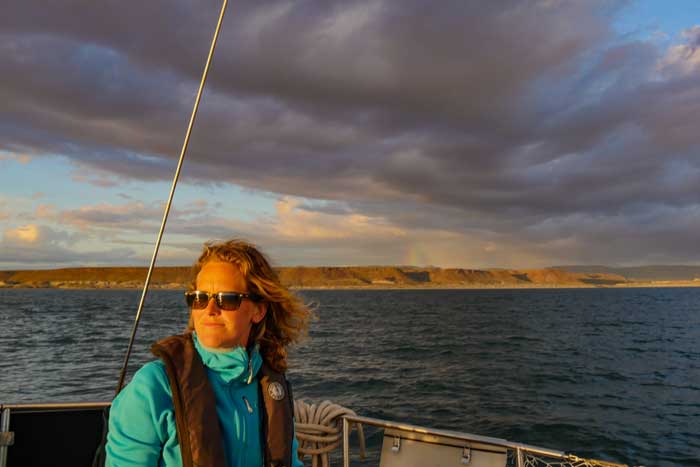
During those two years, we saw ships, sharks and savage storms. We stopped in over 50 different communities and spoke with thousands of people. We got married. One of the most powerful El Niño events warmed the Pacific Ocean and played a deadly game of heat and drought with land and sea. We sailed through the two hottest years ever recorded on earth.
Distilling the experience into themes seems both futile and necessary. I want the hundreds of people I interviewed to have a voice that travels like sound underwater: with precision, purpose and an echo that carries far beyond the original call. They hold the clues to understanding how to adapt locally, even when governments fail.
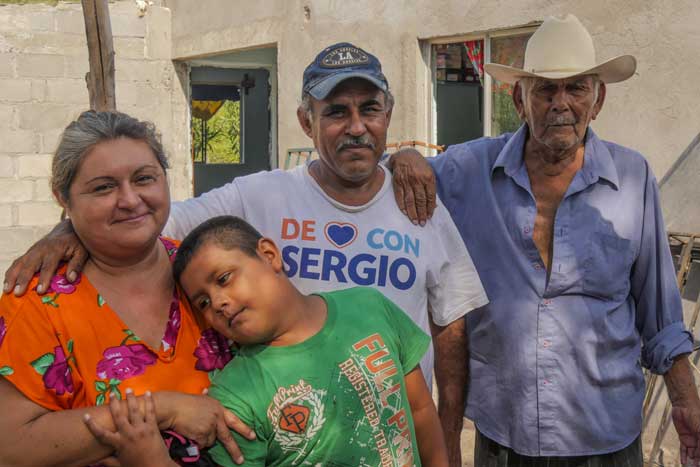
and remote fishing village for at least five generations
Most of what I learned about climate change and adaptation came as a complete surprise. So to honor the voices and conditions I observed, here are the trends that emerged from two years at the edge—from the people, the land and the sea. Some are cultural while others personal, but they were all learned from a life sharing space with real people and the real changes that affected our daily lives together.
Climate change is already affecting the coasts of Latin America—but not in the ways we expect. When we started our sail, I suspected we would find little evidence of climate change. Regional climate models showed only moderate warming. But we found that every small community we visited had already been hit in some way.
Some of the most-often reported and tangible impacts of climate change are the hazards of sea-level rise: storm surges, inundation and erosion.
However, people who live on the coast aren’t thinking about that: they’re most concerned about warm water, heavier and more erratic rainfalls, and less reliable seasons.
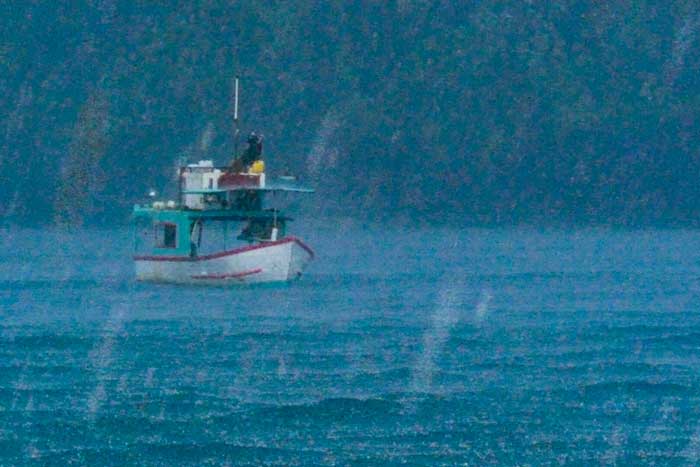
When we set out, I thought that we would hear about the ocean eating away at the coasts, and visually, it is: increasingly high tides reach the structures built at the edge of the sea nearly every place we visit. But it is a regular, integrated occurrence for life on the coast here, and I struggled to find anyone who lamented the damage of hurricanes that sweep higher and take away entire buildings. That mentality seems cultural: people accept the conditions, and rebuild, using community labor and inexpensive materials like thatch and concrete.
However, the warm water associated with El Niño hit both fishers and tour operators hard. The warm water means fewer fish and far fewer whales. Fishers can barely make enough money to survive, and the desperate tour operators who normally operate whale-watching trips are putting additional pressure on other ocean activities (to the detriment of places like Las Tres Marietas, a national park island chain in Mexico completely overrun with national tourists.)
Although El Niño conditions come and go (with increasing severity), there is a climate change constant on the Pacific coast, and it’s a heavy hitter: changing and unpredictable seasons. No matter where we go or with whom I speak, every single person points to the fact that the rainy season no longer starts or ends at a predictable time, nor do the rains happen with the same consistency.
Fishers, farmers, store clerks and taxi drivers can consistently cite this piece of data and describe the implication for their lives and those around them. Crops are weakened and deteriorate without consistent rain. Insects and pests flourish. Entire coffee plantations, called fincas, already deeply damaged by the coffee rust fungus, washed away in one torrential rain five years ago. That devastated the mangroves and therefore the fisheries downstream, since mangroves are crucial havens for juvenile fish and crustaceans.
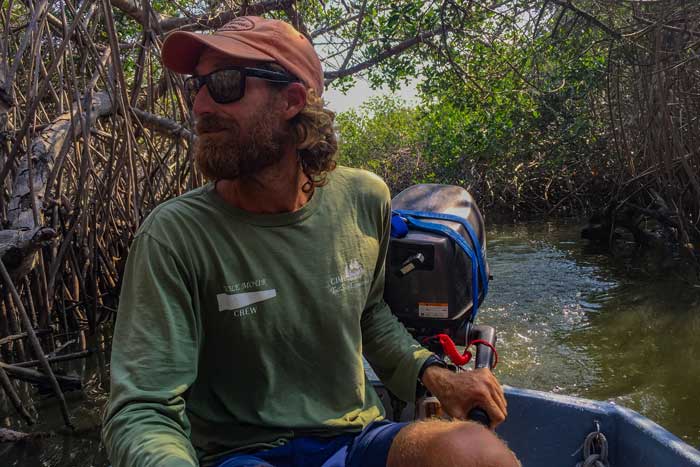
As a result, subtle climate changes on land—a single torrential rainstorm—can have a huge impact on the sea for years. The land and sea cycles affected are irrevocably intertwined. As much as I wanted to single out sea level rise for my research, the actual conditions on the sea and shore dictated otherwise.
Climate is the last straw in a sea of accumulated damages. In some areas, such as the Baja side of the Gulf of California, both the local fishers and larger international boats have already devastated the fisheries, damage that started in the 1950s. However, the issues of local versus international persist in the unguarded waters off southern mainland Mexico: the local rod-and-reel fishers can’t compete with the massive Mexican and Japanese ships that use helicopters to spot schools of tuna and then scoop them up in giant nets. With tuna already scarce near shore because of El Niño’s warm water, that final straw in an already devastated fishery tipped local fishers into action. They joined together to protest and patrol their waters, harassing any foreign boats attempting to come near shore. Protesting in Mexico can be a dangerous undertaking, but a change in the climate pushed the group to defend their resources.
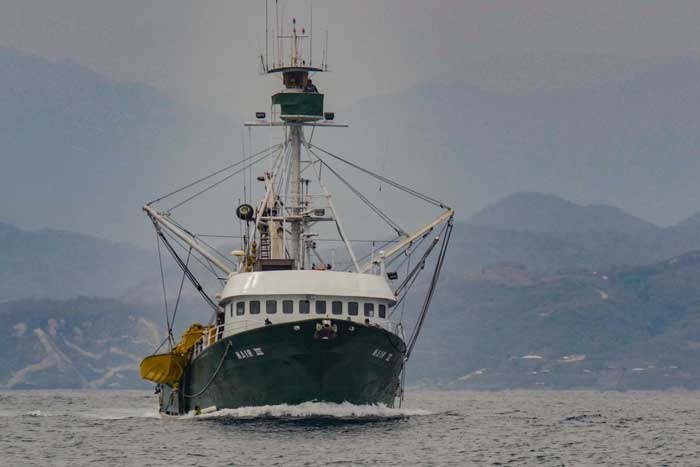
Climate change thus acts as a tipping point in a long history of coastal ecosystem abuse. Rural communities rely directly on agricultural land and ocean fisheries. However, for at least 50 years, those resources have experienced unsustainable levels of depletion, pollution, increased pests, foreign theft of land and water rights and usage, and limited state regulation and enforcement. When climate change exacerbates existing challenges, it disproportionately affects those poor communities.
Therefore, we have to look past “climate” to adapt to local climate change. Resilience depends on the other pressures on the system. Although climate change can act as the final stressor on an ocean system already deteriorated by overfishing, pollution, tourism and lack of regulation, many of those impacts are local.
Resilience lies in looking at places historically to understand the individual, discrete issues that create the struggle for survival. Without understanding the conditions that got communities to their current state of vulnerability to climate change, the root continues to rot. In that way, climate change resilience isn’t about the physical impacts on sea and shore, but finding the keys to underlying health—which depend on communities’ specific resources and history.
These impacts amalgamate to feel deeply entwined in the community’s fabric. Coastal people often talk about “consciencia,” or conscience, when they discuss climate change. The word came up so frequently in my interviews and dialogue that I took special note of it. People use it when describing how their communities have fractured. They identify it as a root problem. I don’t know what actions can be taken to strengthen a community’s consciencia, but distinctly sensed that, by addressing this erosion, a greater consciousness was organically arising.
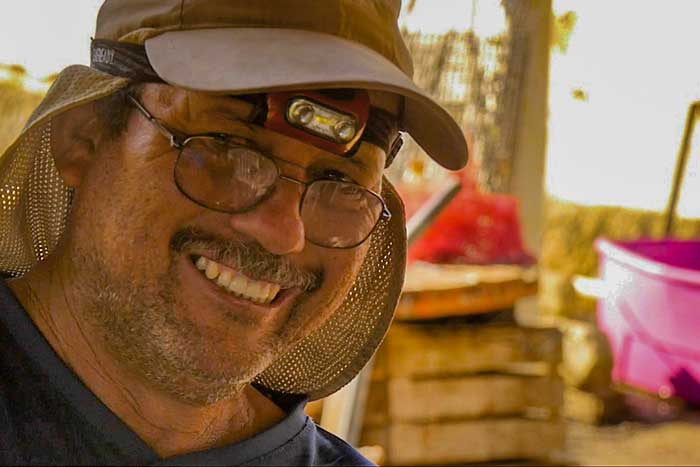
on Isla Isabel on Mexico’s Pacific coast, was one of the people I interviewed who talked about
cultivating consciousness of the natural world on which we all depend
People often don’t recognize their own adaptations to climate change. Many communities have been forced to adapt to fewer fish, changing seasons, increased drought. But they often don’t perceive their resilience as a point of pride or even recognize it. Why?
As one of my interviewees suggested, it could be the result of an entrenched narrative of aid culture (foreign government and aid organizations telling people in various and continuous ways that they are “undeveloped.”) Or perhaps they don’t have time or education for positive self-reflection and community awareness. Or it could stem from a cultural machismo in the face of danger. Or perhaps it reflects a global culture that values formal education and city life over rural subsistence living. But the discrepancy intrigues me even as I continue to search for a nuanced answer.
The issues facing each community are surprisingly different. However, one change positively affects them all: education. The lack of education for rural communities, especially indigenous communities, is mind-bending. Even the most basic concepts—disease transmission, sanitation, trash disposal, animal care—were not taught in the culture or schools in some places. I met a one-and-a-half-year-old child with drug-resistant tuberculosis and could not understand why the parents did not continue to administer the necessary and free drugs for their baby. But without adequate education about how and why the drugs worked, why would they?
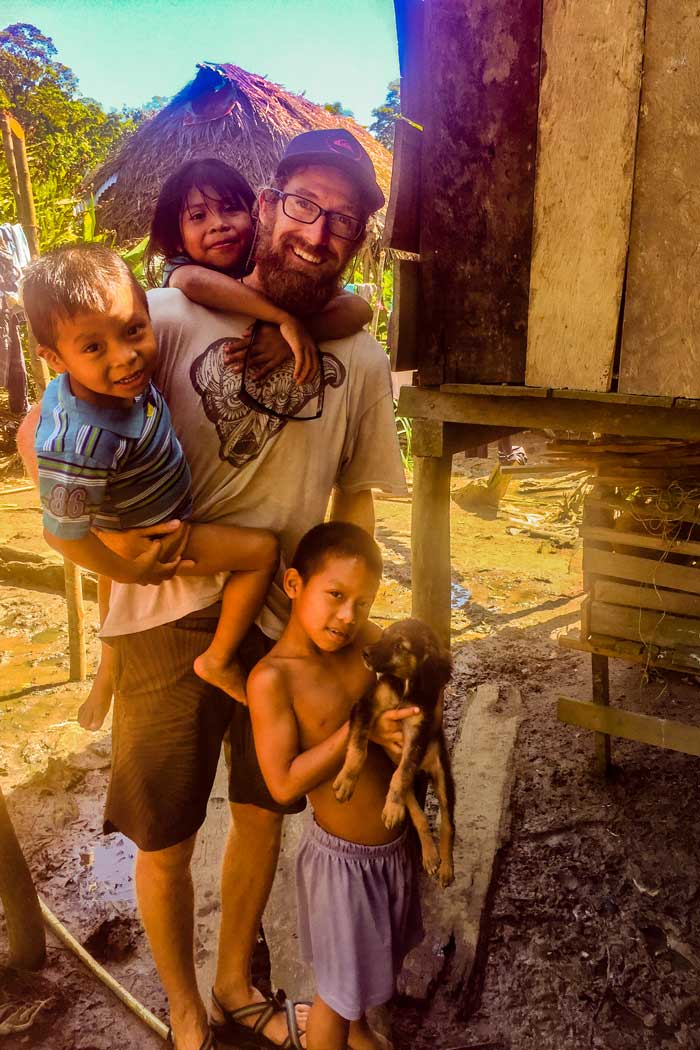
The informal education structures that could keep people alive had disintegrated in many rural areas. Parents would send their children to any school available, no matter the training or religious indoctrination, because they desperately wanted them to learn more than they knew—even when they did not know what their children were being taught.
That was the biggest reason people worried—they wanted their children and grandchildren to be able to get a good education. Most of those I interviewed had completed the equivalent of grade school and wanted more for their kids. It was with relief and hope that some told me about new high schools in their communities—keeping kids close to their roots but with the worldly benefit of education. And when children left to pursue college, the parents positively glowed with pride. Some communities with long-term, personal investment from NGOs received formal and informal education for both adults and children, helping them look toward a more diversified future in which they could still benefit from local knowledge of the sea.
“Education” is not enough—tailored education is the key to help communities thrive in a changing climate. In many rural places, education meant a way out of poverty, but didn’t concern community preservation or any sense of sustainability. It was reading, writing and some arithmetic. Although those skills are crucial, they often stand starkly apart from local or indigenous skills, and the leap isn’t made to integrate and apply the different skill sets.
But on the Baja California coast, an embedded non-profit teaches fishers in the community how to regulate their catches. The same organization teaches weekly classes in the local school system about ecosystem health; as a result, a local kid became a marine biologist, and children in the community now also grow up wanting to be marine biologists. That is long-term, economy- and environment-specific education. It taps into local customs and pride, and requires long-term investment.
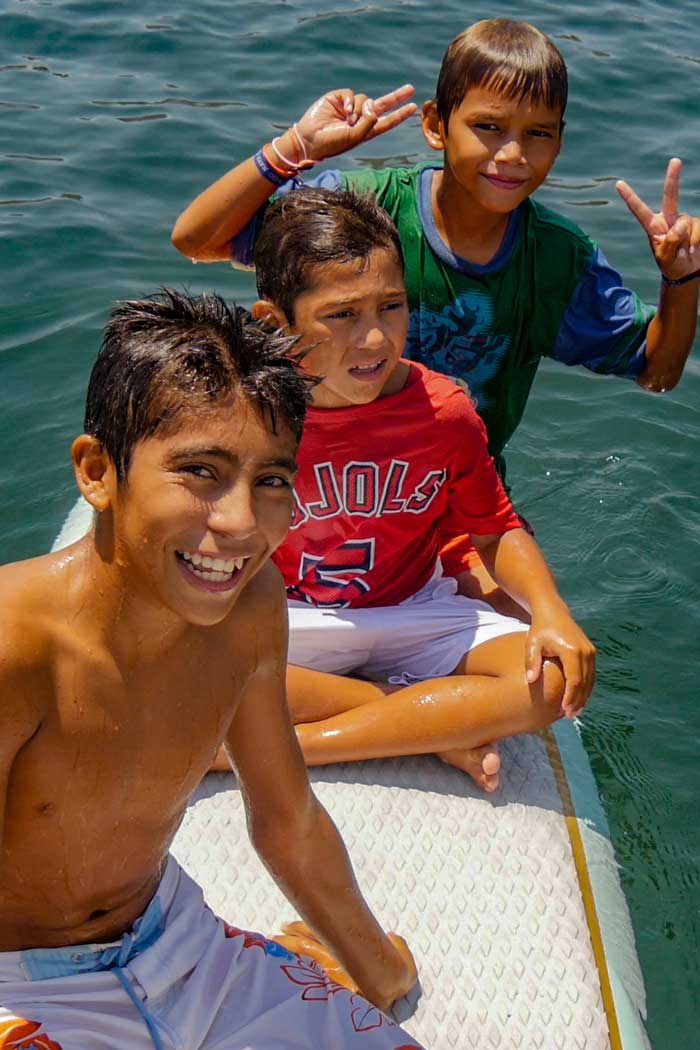
Policing the sea is a huge task. And yet it must be done. Many countries don’t have the resources or the state-level integrity to enact or enforce laws that would preserve a healthy and robust ocean. In this case, larger, wealthier countries can step in to enforce international laws. But the sea is huge, and finding and arresting poachers a tough and dangerous job. Much like attempting to combat systemic corruption, the solution likely involves a complex political shift that prioritizes people over profit.
Plastic is overwhelming the ocean. By 2050, there will be more plastic in the ocean than fish, outweighing fish pound for pound, the World Economic Forum reports. Reporting from the deck of our sailboat, I can tell you that every spot where two currents meet and create a “line” in the ocean, even as close as 50 miles from shore, contains plastic and styrofoam. We saw thousands and thousands of bottle caps, bags and microplastics in those lines. Current lines also attract fish, and as a result, sea birds, turtles, dolphins and whales. They are where many organisms go to feed. Every time I see a decomposing bird on the beach, its gut is full of plastic.
The plastic comes from negligence ashore—there’s a desperate lack of systemic trash disposal in almost all coastal towns and those upstream, and there’s no unified movement (yet) opposed to using plastic and styrofoam in most places (including the United States.) In the meantime, we need secure and reliable trash disposal in coastal communities to benefit ocean health.
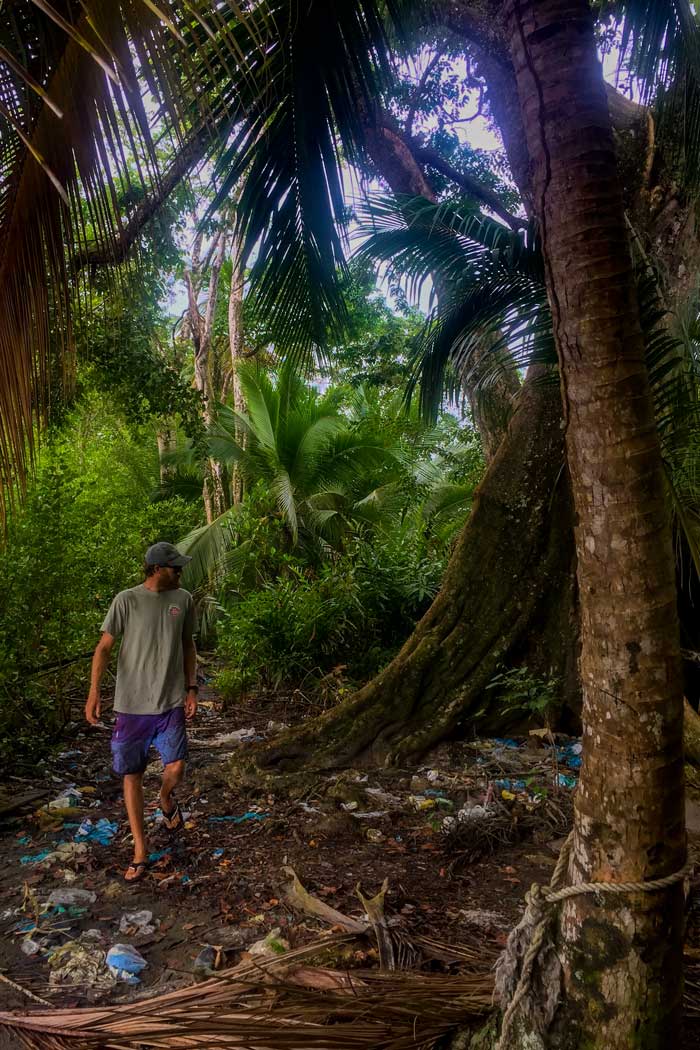
our most common finds were plastic bags and bottles of all shapes and sizes and disposable diapers
In the past 15 years, I’ve observed a marked improvement in coastal trash disposal in Mexico. However, as we sailed south (and into more impoverished areas), we found more garbage in the water and ashore. One of the most devastating scenes was in the Gulf of Fonseca, a large bay shared by El Salvador, Honduras and Nicaragua, where the lack of clean drinking water and trash disposal means residents typically buy sandwich-sized bags of drinking water that they toss into the sea when empty. The seawater was full of bags that looked just like jellyfish—the main food for some sea turtle species. In this case, a local solution to plastic pollution involves a mix of long-term education and the challenging battle of poverty alleviation.
But there is so much hope! Given a chance, the sea recovers. And rapidly, in many cases. At Isla Isabel, on Mexico’s Pacific coast in Nayarit, the island was trashed by fishers and invasive species on land, and devoid of life on the reefs and surrounding waters 20 years ago. After it was declared a national park, and with national and international research and funding to support its transition, the island and surrounding waters rebounded to a level the local fishers had never seen before, all within 15 years.
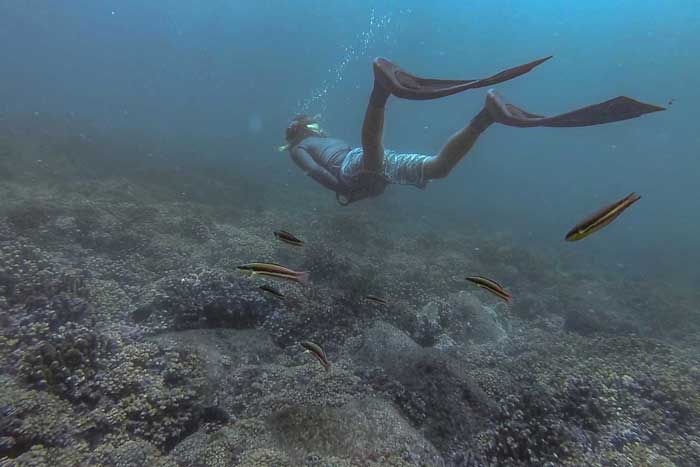
Coral bleaching is devastating, but with concentrated local effort, recovery is possible. The system may look different than before, but such change presents an opportunity to develop a deeper understanding of what makes a local underwater environment thrive. And it is through unlikely, long-term partnerships between disparate people or groups, from locals to international researchers, that ocean ecosystems stand a chance to survive as the climate changes.
Partnership is crucial to discovery. In US culture, we glorify the “individual,” particularly crusaders who take on feats alone. Within the sailing community, we admire the “singlehanders,” the people who sail solo. But in my experience on the sea, I found that partnership made it possible for us to grow as individuals, which gave us the time and space to expand our understanding of coastal people and places.
Never in a million years could I have imagined the ways the boat would break—or the ways I would break. Josh kept us alive at least a dozen times. He knew how to bypass the busted starter using a wrench to create an electrical circuit when a storm moved into an anchorage and we needed to leave within half an hour of sunrise. He took almost an entire night watch in a thunderstorm that crashed all around us while sailing on the most remote part of the Costa Rican coast. We filled the gaps in each other’s knowledge, which kept us constantly open to possibility.
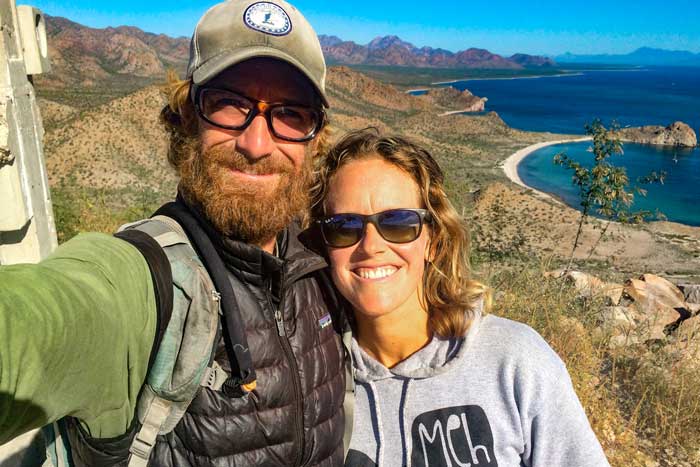
Through it all, we remained a team. Here, we waited for weather, pinned down
by 40 mile-per-hour winds and raging tides, at remote Isla Tiburón, Sea of Cortez, Mexico
That is not exclusive to sailing, of course. Partnership across borders lifts people up and sustains them, even when local conditions seem grim. In San Pancho, Nayarit, Mexico, a small birding organization is attempting to protect local and migrating birds. By partnering with a similar group in Oregon, they receive financial, psychological and even business-development support. Banding together across borders makes the cumulative impact of both organizations broader than either one’s alone.
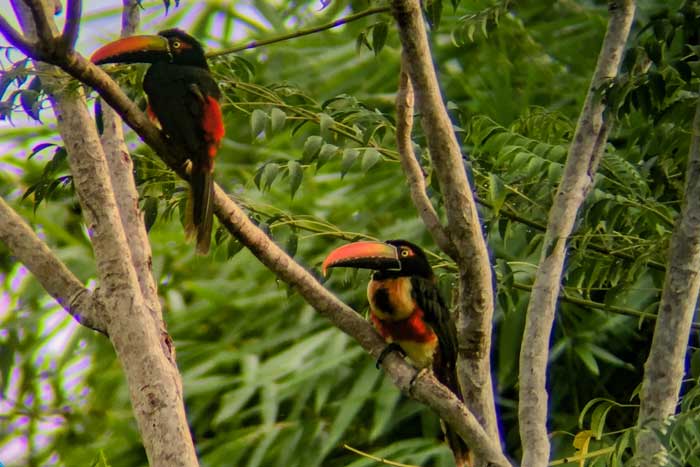
that support bird diversity thrive best when they do the same
Sailing allowed me to learn not only the perspective of fishers, but the silent voice of the ocean. Sailing is not an efficient way to collect data or interviews. The fastest we moved was seven knots per hour, and we were consistently pinned down by weather. I sometimes felt overwhelming frustration when unable to go to shore because of bad weather, or from my desire to meet and speak with more people when safety and weather necessitated moving on.
However, I slowly came to see that the experience of living on the water taught me firsthand about the ocean. I am far more observant and attendant to weather, currents and global weather patterns—which in turn makes me a better scientist and more open to and aware of possible hidden changes. I may not have more “data,” but I’m a more well-rounded person who can speak about the conditions—and the heart—of the ocean.
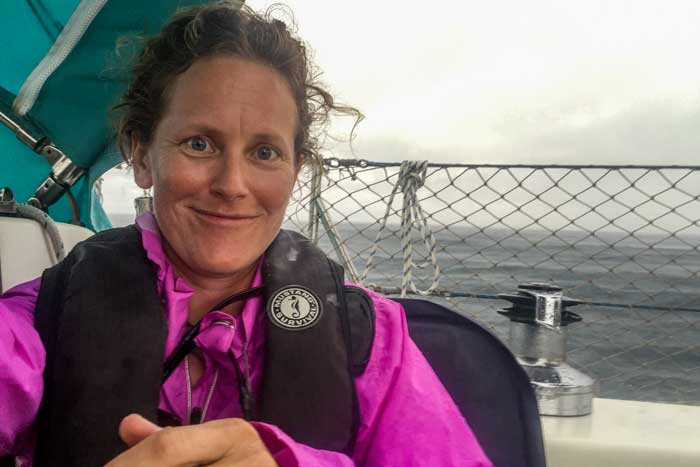
rain behind the dodger, somewhere off the coast of Costa Rica
It’s not about the elimination of fear, but the journey of working through it. I never used to admit being afraid. But while sailing, writing and interviewing, I’ve discovered that fear is an intrinsic part of the human experience—and a piece of commonality that paradoxically unites people.
Sometimes there is no good decision. In a clash of cultures, I sometimes found myself having to choose between multiple options, all of them poor. I still ask myself if I could have done a better job or found a better solution. Ultimately, all my training and imagined moral high ground disappeared when facing decisions about alleviating suffering. That gave me even more compassion for aid workers, soldiers and anyone else trying to give that “imperfect offering” in ambiguous circumstances.
It’s easy to assign a solution—until living in the situation. That is why many who study climate adaptation have replaced the concept of concrete solutions with more resilience. As an academic, I despised the grasping nature of the term. But on the ground, it allows for a more supple and mutable approach to an amorphous bag of threats, rooted as much in 500-year-old cultural paradigms as in the physical phenomena that clobber the shores. Instead of solutions that make problems go away, resilience can look at a host of vulnerabilities and builds the capacity to adapt, even while acknowledging historical blind spots and future uncertainties.
I had to figure this process out on a personal level when I became pregnant. Many of the struggles of pregnancy can’t be “solved,” and responding to each situation without a longer perspective left both my family and me exhausted and compromised. A solved issue did not prevent or placate a future one. Instead, I had to be poised for the unexpected. To do that, I had to leave the rural coasts for the time being. Although at first, I felt leaving Latin America would be a betrayal of the people I met, I realized I needed to be better positioned, and supported, to safely live the reality of a high-risk pregnancy.
Despite that worry of abandonment, my commitment has not diminished with distance; indeed, my perspective grows as I process our three years in Latin America. I can see more clearly the complexities of moving from researcher to practitioner. Imperfection is the rule, not the exception. Nor is my relationship with Latin America and raising a child an either/or paradigm: I can commit to one without abandoning the other. I will learn to create new ways to serve both, built on creatively reorganizing my past experiences.
Any sort of adaptation—or living, for that matter—requires trial and failure. Resilience, outside the strict definitions of ecology, does not require bouncing back to the previous state—it leaves room for unknowable change. And I’m okay with that. I have invested for the long term, and just like going upwind in a sailboat, the only way forward requires tacking, patience, reading the charts, but always keeping an eye out for what I don’t know.
* * *
In the end, these lessons taught me how to handle a storm. Not the kind where I admire the power of nature from the safety of my living room, but where I’m exposed and fighting for my life.
One experience in particular highlighted our evolution for me. Totally alone out on the ocean, in one of the most remote areas of Caribbean Panama, our transmission died just as I was hoisting the main sail. We were leaving an anchorage on a dangerous lee shore, so we couldn’t turn around and safely anchor there again. As if on cue, the winds picked up to 30 knots, and the sea punched our hull with continuous whitecapping waves. We were forced to sail dead on into a storm.
The closest town, our destination, was over 40 long nautical miles away. We had no cell service. Staring down such conditions feels a lot like experiencing the fear and anxiety of the unknown that comes with big change—plus the uneasy immediacy of contemplating one’s own possible demise.
We could have turned around, ridden out the storm while losing ground in open water: gone with the wind and waves, a more comfortable direction for the boat. But we had places to see, people to meet and a sturdy craft that knows how to sail upwind. So we pressed our little boat forward in building seas. We sailed strategically; we used the coastline ahead of us to gain some shelter from the swell and chop.
When a wave that crashed over the hull ripped our paddleboards—the main form of transportation to shore—off the side of the boat, I despaired. I said let them go. But even as I said that, I never took my eyes off them in the churning seas. That is the key to saving anything overboard: never let it out of your sight. With my eyes fixed on the boards, Josh suggested we at least try to get them back. We calmly discussed our plan. He turned the boat into the howling wind. Even as the storm rattled the wires and my nerves, we sailed back downwind for the boards and, almost miraculously, managed to pull them both out of the angry sea.
For the first part of that day, we traveled over twelve nautical miles, but made only two miles in the direction of our course. We had to tack backward to go forward. Without a motor, we were forced to be more in tune with our conditions. We discussed turning around a few times. But we didn’t. Wet, cold and fatigue saturated my bones as I constantly shifted our sails and hand-steered all day in the gusty wind and driving cold rain. The winds mocked our attempts to navigate with their capricious gusts. But after a while, we learned how to push the boat into the gusts and when to expect them.
We eventually got the transmission working and set a more comfortable course into the wind. We had the knowledge and accumulated experience (earned in previous rough sails) to do that. Around the same time, the winds eased and the crashing waves abated. The ship no longer had to dunk her bow to fight forward. But we persevered through some very uncomfortable, scary conditions in the meantime. There wasn’t so much an absence of fear asthe ability to make good decisions with it present. There was love and trust between the two of us, and we placed confidence in the boat. Sometimes we forget how good we are as a team; it takes an unexpected failure and a storm to remind us.
We are more ready than we think. The daily, insidious onslaught against underrepresented people, our climate and the environment means we have been practicing our whole lives for the challenge ahead. The storm was the test and the opportunity that we needed.
We may be required again to go backward on the path forward. It calls forth our dragons but also highlights our resilience. We have each other. We have a good boat. We have wits, grit and humor, and we know how to keep our eyes laser-focused on our task. We are fortunate to be in this time, with this opportunity to hoist our sails, turn into the wind and put to sea.
